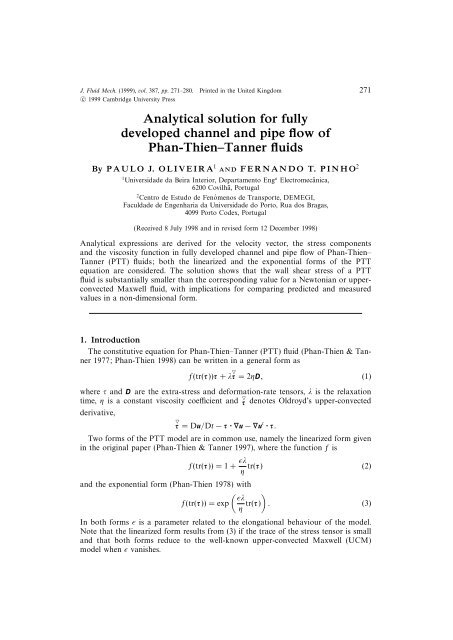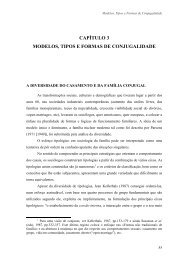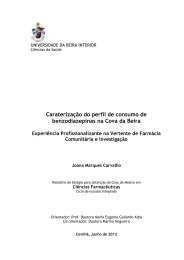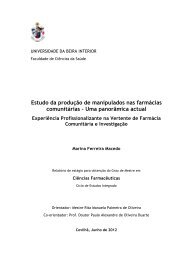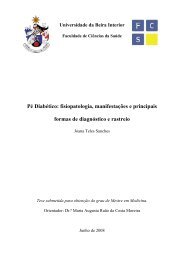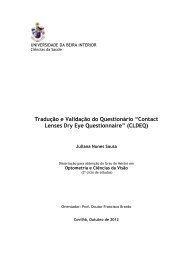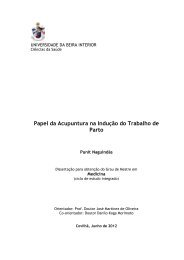Analytical solution for fully developed channel and pipe flow of Phan ...
Analytical solution for fully developed channel and pipe flow of Phan ...
Analytical solution for fully developed channel and pipe flow of Phan ...
- No tags were found...
Create successful ePaper yourself
Turn your PDF publications into a flip-book with our unique Google optimized e-Paper software.
J. Fluid Mech. (1999), vol. 387, pp. 271–280. Printed in the United Kingdomc○ 1999 Cambridge University Press271<strong>Analytical</strong> <strong>solution</strong> <strong>for</strong> <strong>fully</strong><strong>developed</strong> <strong>channel</strong> <strong>and</strong> <strong>pipe</strong> <strong>flow</strong> <strong>of</strong><strong>Phan</strong>-Thien–Tanner fluidsBy PAULO J. OLIVEIRA 1 AND FERNANDO T. PINHO 21 Universidade da Beira Interior, Departamento Eng a Electromecânica,6200 Covilhã, Portugal2 Centro de Estudo de Fenómenos de Transporte, DEMEGI,Faculdade de Engenharia da Universidade do Porto, Rua dos Bragas,4099 Porto Codex, Portugal(Received 8 July 1998 <strong>and</strong> in revised <strong>for</strong>m 12 December 1998)<strong>Analytical</strong> expressions are derived <strong>for</strong> the velocity vector, the stress components<strong>and</strong> the viscosity function in <strong>fully</strong> <strong>developed</strong> <strong>channel</strong> <strong>and</strong> <strong>pipe</strong> <strong>flow</strong> <strong>of</strong> <strong>Phan</strong>-Thien–Tanner (PTT) fluids; both the linearized <strong>and</strong> the exponential <strong>for</strong>ms <strong>of</strong> the PTTequation are considered. The <strong>solution</strong> shows that the wall shear stress <strong>of</strong> a PTTfluid is substantially smaller than the corresponding value <strong>for</strong> a Newtonian or upperconvectedMaxwell fluid, with implications <strong>for</strong> comparing predicted <strong>and</strong> measuredvalues in a non-dimensional <strong>for</strong>m.1. IntroductionThe constitutive equation <strong>for</strong> <strong>Phan</strong>-Thien–Tanner (PTT) fluid (<strong>Phan</strong>-Thien & Tanner1977; <strong>Phan</strong>-Thien 1998) can be written in a general <strong>for</strong>m asf(tr(τ))τ + λ τ =2ηD, (1)where τ <strong>and</strong> D are the extra-stress <strong>and</strong> de<strong>for</strong>mation-rate tensors, λ is the relaxationtime, η is a constant viscosity coefficient <strong>and</strong> τ denotes Oldroyd’s upper-convectedderivative,τ =Du/Dt − τ ·∇u − ∇u t · τ.Two <strong>for</strong>ms <strong>of</strong> the PTT model are in common use, namely the linearized <strong>for</strong>m givenin the original paper (<strong>Phan</strong>-Thien & Tanner 1997), where the function f isf(tr(τ))=1+ ɛλ tr(τ) (2)η<strong>and</strong> the exponential <strong>for</strong>m (<strong>Phan</strong>-Thien 1978) with( ) ɛλf(tr(τ)) = expη tr(τ) . (3)In both <strong>for</strong>ms ɛ is a parameter related to the elongational behaviour <strong>of</strong> the model.Note that the linearized <strong>for</strong>m results from (3) if the trace <strong>of</strong> the stress tensor is small<strong>and</strong> that both <strong>for</strong>ms reduce to the well-known upper-convected Maxwell (UCM)model when ɛ vanishes.
Fully <strong>developed</strong> <strong>flow</strong> <strong>of</strong> <strong>Phan</strong>-Thien–Tanner fluids 273the equations <strong>of</strong> motion that the pressure gradient p ,x is constant <strong>and</strong> integration <strong>of</strong>the longitudinal momentum equation, subjected to the boundary condition τ xy =0atthe symmetry line y = 0, yieldsyτ xy = p ,x2 . (7)jWith the above simplifications <strong>and</strong> upon division <strong>of</strong> the expressions <strong>for</strong> the two nonvanishingstresses (equations (4) <strong>and</strong> (6)) the specific function f cancels out resulting inτ xx = 2λ y 2η p2 ,x . (8)22j Note that equation (8) is consistent with the required boundary condition at thecenterline, i.e. τ xx =0aty = 0. After combining (6), (7) <strong>and</strong> (8) we come to theimportant conclusion that the velocity gradient is given by˙γ ≡ du ( ) 2λdy = f y 2 p,x yη p2 ,x2 2j η 2 , (9)jan explicit differential equation in y which can be directly integrated to give thevelocity pr<strong>of</strong>ile once the function f is specified.2.1. Linear PTT modelWith f given by equation (2), equation (9) can be integrated subject to the no-slipboundary condition at the wall (y = H) <strong>and</strong> the resulting velocity pr<strong>of</strong>ile is thefollowing cubic equation in the pressure gradient:()u(y) = −p ,x2 j+1 η (H2 − y 2 )1+ ɛλ2 p 2 ,x2 2j η 2 (H2 + y 2 ). (10a)It is <strong>of</strong>ten more convenient to work with the non-dimensional <strong>for</strong>m <strong>of</strong> this equation,obtained after scaling distances with H, velocities with the cross-sectional averagevelocity ū <strong>and</strong> stresses or pressure with ηū/H. In this way, it will be easier to derivethe relevant equations <strong>for</strong> the inverse problem <strong>of</strong> determining the pressure gradientwhen the <strong>flow</strong> rate is known, the common situation in an experiment. After somemanipulation, the non-dimensional velocity pr<strong>of</strong>ile can be written asu(y)ū= κūN ū(1 −( yH) 2 )(1+4κ 2 ɛDe 2 (ūNū) 2 (1+( yH) 2 ))(10b)where κ takes the values 1.5 <strong>and</strong> 2 <strong>for</strong> plane or axisymmetric <strong>flow</strong>s, respectively. Inequation (10b) the parameter ū N is defined asū N ≡ −p ,xH 2(11)2 j+1 kη<strong>and</strong> represents the cross-sectional average velocity <strong>for</strong> the Newtonian or the upperconvectedMaxwell fluid cases. Note also that ū N /ū is nothing other than a nondimensionalpressure gradient. The dimensionless group De = λū/H is the Deborahnumber, a measure <strong>of</strong> the level <strong>of</strong> elasticity in the fluid, <strong>and</strong> is based on the averagevelocity ū. ForDe =0orɛ = 0, the above equations reduce to the well knownparabolic pr<strong>of</strong>ile with a maximum velocity at the centreline given by (u 0 ) N = κū N .Thus the second term in the brackets <strong>of</strong> equation (10) represents a corrective (oradditional) term, relatively to the parabolic pr<strong>of</strong>ile, <strong>and</strong> is connected to the PTTmodel.
274 P. J. Oliveira <strong>and</strong> F. T. PinhoThe pressure gradient −p ,x is usually unknown but can be related to the crosssectionalaverage velocity through the definition <strong>of</strong> the <strong>flow</strong> rate following Bird,Armstrong & Hassager (1987)ū ≡ 1 ∫ H2 j y j u(y)dyH j+1 0<strong>and</strong> the integration yields the <strong>solution</strong> <strong>of</strong> the direct problem, the flux <strong>for</strong> a givenpressure gradientū =()−p ,x H 21+ ɛλ2 p 2 ,xH 2 (j +3). (12)η(j + 1)(j +3) 2 (2j−1) η 2 (j +5)For the <strong>solution</strong> <strong>of</strong> the inverse problem, the determination <strong>of</strong> the pressure gradient<strong>for</strong> a given flux, it is advantageous to work with the normalized velocity pr<strong>of</strong>ile (10b)which needs to be integrated to yield the following non-dimensional cubic equation<strong>for</strong> ū N /ū:1=ūN ū( ) 2 ) (ūN1+būwith8(3 + j)κ2b ≡ ɛDe 2 .(5 + j)This equation shows that ū N < ū, i.e. <strong>for</strong> an identical longitudinal pressure gradient ahigher <strong>flow</strong> rate results <strong>for</strong> the PTT fluid than <strong>for</strong> the Newtonian fluid on account <strong>of</strong>the shear-thinning behaviour. From the Cardan–Tartaglia <strong>for</strong>mula <strong>for</strong> the <strong>solution</strong> <strong>of</strong>algebraic cubic equations it can be readily shown that the real <strong>solution</strong> <strong>of</strong> (13) isū Nū = (432)1/6 (δ 2/3 − 2 2/3 )(14)6b 1/2 δ 1/3with the following definitions used to simplify the notation:α =3 3 b +4; β =3 3/2 b 1/2 ; δ = α 1/2 + β.Equation (14) gives the explicit relation <strong>for</strong> the pressure gradient as a function <strong>of</strong> thecross-sectional average velocity ū, once ū N is substituted by its definition (equation(11)). The main results <strong>of</strong> the analysis <strong>for</strong> the linearized PTT fluid are there<strong>for</strong>e thevelocity pr<strong>of</strong>ile (10), the flux equation (12) <strong>and</strong> the unknown driving pressure gradientat given <strong>flow</strong> rate obtained from (14). The maximum velocity at the centreline (y =0)is also useful <strong>and</strong> is given byu 0ū = κ1+4κ2 ɛDe 2 (ū N /ū) 21+b(ū N /ū) 2showing that it is smaller than in the Newtonian case. Expressions <strong>for</strong> the normalizedstress components are readily obtained after scaling with the wall shear stress <strong>for</strong>the Newtonian (or UCM) fluid. From equation (8), the non-dimensional normalstress is) 2 ( ) 2τ xx(ūN y2κη ū/H =4κDe (15)ū H(13)
Fully <strong>developed</strong> <strong>flow</strong> <strong>of</strong> <strong>Phan</strong>-Thien–Tanner fluids 275<strong>and</strong> the normalized shear stress component is calculated from (7):)( )τ xy(ūN y2κη ū/H = − . (16)ū HThe shear strain rate, from (9), becomes˙γ(y)2κ ū/H = −ūN ū<strong>and</strong> the viscosity pr<strong>of</strong>ile isµ(˙γ) ≡ τ xy˙γ⇒ µ(˙γ)η( yH)(1+8κ 2 ɛDe 2 (ūNū=) 2 ( yH) 2 )(17)() 2 ( ) 2 ) −1 (ūN y1+8κ 2 ɛDe 2 . (18)ū HWall values <strong>for</strong> these quantities are useful to define non-dimensional quantities <strong>and</strong>are obtained after setting y = H:) 2 ) −1µ w(ūN(1+8κη = 2 ɛDe 2 (τ xy ) w,ū 2κη ū/H = ūN <strong>and</strong>ū) 2(τ xx ) w(ūN2κη ū/H =4κDe ,ū(19)where (τ xy ) w is defined positive. These values are smaller than the corresponding values<strong>for</strong> the UCM fluid, a point to be taken into account when comparing non-dimensionalvalues.2.2. Exponential PTT modelThe normal <strong>and</strong> shear stress pr<strong>of</strong>iles are independent <strong>of</strong> the function f(trτ), there<strong>for</strong>ethey are still given by equations (15) <strong>and</strong> (16), respectively. However, the ratio ū N /ūin those expressions is different since it depends on the new velocity distribution. Thisdistribution is obtained in a similar way by inserting the new f function (equation(3)) into equation (9) followed by integration, to yield the dimensional <strong>and</strong> thecorresponding non-dimensional <strong>for</strong>ms <strong>of</strong> the velocity pr<strong>of</strong>ile, respectively:<strong>and</strong>u(y) = exp(ɛλ2 H 2 p 2 ,x/(2 (2j−1) η 2 ))−p ,x ɛλ 2 /(2 j−2 η)u(y)ū= κūN ū(1 − exp(− ɛλ2 p 2 ,xη 2 2 2j−1 (H2 − y 2 )))(20a)exp (b(ū N /ū) 2 )b(ū N /ū) 2 (1 − exp(−b(ū N /ū) 2 (1 − (y/H) 2 ))), (20b)where now b ≡ 8κ 2 ɛDe 2 . This is also valid <strong>for</strong> the axisymmetric case, after effectingthe appropriate changes. Appropriately, in the limit <strong>of</strong> small b(ū N /ū) 2 , equation (20b)tends to the parabolic pr<strong>of</strong>ile, as it should.The equation relating the <strong>flow</strong> rate <strong>and</strong> the pressure gradient, required <strong>for</strong> the<strong>solution</strong> <strong>of</strong> the direct problem, is no longer common to both geometries. For the<strong>channel</strong>, we obtain( 2ɛλ 2 p 2 ,xH 2ū =−η (exp4ɛλ 2 p ,xη 2 )−η2λp ,x Hπ 1/2 erf (i(λp ,x H/η) √ )2ɛ)i √ 2ɛ(21a)<strong>and</strong> <strong>for</strong> the <strong>pipe</strong>ū =−η ( ɛλ 2 p 2 ,xH 2 )(exp1+ exp(−ɛλ2 p 2 ,xH 2 /(2η 2 )))−1. (21b)2ɛλ 2 p ,x 2η 2 ɛλ 2 p 2 ,xH 2 /(2η 2 )
276 P. J. Oliveira <strong>and</strong> F. T. Pinho1.00.80.6u Nu0.40.20 2 4 6 8 10ε 1/2 DeFigure 1. Variation <strong>of</strong> the average velocity ratio ū N /ū with ɛ 1/2 De (solid line: plane <strong>flow</strong>; dashedline: axisymmetric <strong>flow</strong>; no symbols: linear PTT; symbols: exponential PTT).ɛ 1/2 De Channel Pipe ɛ 1/2 De Channel Pipe0.05 0.9746 0.9526 1.0 0.3134 0.24710.1 0.9132 0.8545 2.0 0.1858 0.14390.2 0.7695 0.6732 3.0 0.1342 0.10330.3 0.6515 0.5492 4.0 0.1059 0.081140.4 0.5628 0.4642 5.0 0.08778 0.067130.5 0.4953 0.4028 6.0 0.07519 0.057400.6 0.4427 0.3565 7.0 0.06589 0.050240.7 0.4007 0.3203 8.0 0.05873 0.044740.8 0.3663 0.2911 9.0 0.05303 0.040360.9 0.3376 0.2672 10.0 0.04839 0.03680Table 1. Numerical <strong>solution</strong> <strong>of</strong> equations (24) <strong>and</strong> (25). Values <strong>of</strong> ū N /ū.The normalized shear-rate <strong>and</strong> viscosity pr<strong>of</strong>iles are readily obtained from (20b) <strong>and</strong>(16):( ) () 2 ( ) 2 )˙γ(y)y(ūN y2κ ū/H = −ūN exp 8κ 2 ɛDe 2 (22)ū H ū H<strong>and</strong>() 2 ( ) 2 )µ(˙γ)(ūN y= exp − 8κ 2 ɛDe 2 . (23)ηū HAgain, <strong>for</strong> the inverse problem <strong>of</strong> determining the pressure gradient <strong>for</strong> a given flux,the non-dimensional velocity pr<strong>of</strong>ile is integrated across the <strong>channel</strong> or <strong>pipe</strong> sectionsto give the parameter ū N /ū. Here, also, different equations are obtained <strong>for</strong> the planar,1= 3 ()ū N exp (b(ū N /ū) 2 )1+ iπ1/2 exp (−b(ū N /ū) 2 ) erf (ib 1/2 ū N /ū)(24)2 ū b(ū N /ū) 2 2b 1/2 ū N /ū
1.0Fully <strong>developed</strong> <strong>flow</strong> <strong>of</strong> <strong>Phan</strong>-Thien–Tanner fluids 2770.8yH0.60.40.2UCM0.10.51.05.00 0.5 1.0 1.5u/uFigure 2. Velocity pr<strong>of</strong>ile <strong>of</strong> the linear PTT fluid in <strong>channel</strong> <strong>flow</strong> as a function <strong>of</strong> the dimensionlessgroup ɛ 1/2 De (solid line: parabolic pr<strong>of</strong>ile; dashed lines: ɛ 1/2 De =0.1, 0.5, 1.0 <strong>and</strong> 5.0).1.00.8yH0.60.4ChannelPipe0.20 0.5 1.0 1.5u/u2.0Figure 3. Comparison <strong>of</strong> the velocity pr<strong>of</strong>iles <strong>for</strong> the linear <strong>and</strong> exponential PTT model in <strong>channel</strong><strong>and</strong> <strong>pipe</strong> <strong>flow</strong> (De = 2 <strong>and</strong> ɛ = 0.1) (solid lines: parabolic pr<strong>of</strong>ile; dashed lines: linear <strong>and</strong>exponential PTT).<strong>and</strong> the axisymmetric cases1=2ūN ū(exp (b(ū N /ū) 2 )1 − 1 − exp (−b(ū )N/ū) 2 ). (25)b(ū N /ū) 2 b(ū N /ū) 2This time, these nonlinear equations are not amenable to an analytical <strong>solution</strong> <strong>and</strong>there<strong>for</strong>e numerical methods are required. We have solved the above equations with
278 P. J. Oliveira <strong>and</strong> F. T. Pinho1.00.8s xysxx(a)yH0.60.40.20–10 1 2De =2UCMε = 0.01ε = 0.1ε = 0.25ε =1.031.0s xys xxDe =1(b)0.8yH0.60.40.2ε = 0.25De = 0.1De =2De =5De =100–10 1 2s ij/(3gu/H )3Figure 4. Pr<strong>of</strong>iles <strong>of</strong> the normalized shear <strong>and</strong> normal stress components: (a) <strong>for</strong> varying ɛ, atconstant De = 2 (solid lines: UCM fluid; dashed lines: ɛ =0.01, 0.1, 0.25 <strong>and</strong> 1.0); (b) <strong>for</strong> varyingDe, at constant ɛ =0.25 (solid lines: Newtonian fluid; dashed lines: De =0.1, 1, 2, 5 <strong>and</strong> 10).a straight<strong>for</strong>ward but robust bisection method <strong>and</strong> the <strong>solution</strong> is shown in figure 1;<strong>for</strong> the sake <strong>of</strong> completeness, a few such values are also given in table 1 from whereother values can be extracted by interpolation.3. DiscussionIt is clear from figure 1 that, <strong>for</strong> identical pressure gradients, the PTT fluid cancarry a larger <strong>flow</strong> rate than the Newtonian or UCM fluids, especially <strong>for</strong> ɛ 1/2 Delarger than 2. This effect is due to an increased shear-thinning behaviour with theparameter ɛ 1/2 De <strong>and</strong> is more intense with the exponential <strong>for</strong>m <strong>of</strong> the PTT model.The shear-thinning behaviour is also observed in the flatter velocity pr<strong>of</strong>iles pertaining
Fully <strong>developed</strong> <strong>flow</strong> <strong>of</strong> <strong>Phan</strong>-Thien–Tanner fluids 279to the plane <strong>flow</strong> <strong>of</strong> the linear PTT fluid in figure 2. As ɛ 1/2 De increases the velocitypr<strong>of</strong>iles flatten in the centre in a similar way to those <strong>of</strong> shear-thinning power-lawfluids (Skell<strong>and</strong> 1967). The exponential <strong>for</strong>m <strong>of</strong> the PTT model leads to velocitydistributions (equations (20), (24) <strong>and</strong> (25)) that are similar to those in figure 2 except<strong>for</strong> the increased shear-thinning behaviour as a consequence <strong>of</strong> the correspondinghigher values <strong>of</strong> the function f, as seen in figure 3. Shear thinning reduces the wallshear stress since the increased shear rate at the wall (cf. du/dy at y = H in figure 2)is outweighted by the reduction in the viscosity; <strong>for</strong> example, <strong>for</strong> De = 2 <strong>and</strong> ɛ =0.1,˙γ w increases by 34% relative to the Newtonian case, but µ w is reduced by 63.4% <strong>and</strong>the net effect is a reduction <strong>of</strong> 51% <strong>of</strong> the wall shear stress.The distributions <strong>of</strong> the normalized τ xy <strong>and</strong> τ xx across the <strong>channel</strong> width areshown together <strong>for</strong> the linear PTT model in figure 4(a), <strong>for</strong> varying ɛ at constantDe, <strong>and</strong> in figure 4(b) <strong>for</strong> varying De at constant ɛ. The trends in figure 4(a) areexpected since ɛ → 0 brings the PTT model close to the UCM model <strong>and</strong> so thestresses should increase in magnitude. In the latter graph, however, the trend is notmonotonic <strong>and</strong> <strong>for</strong> high elasticity (high De) the normal stresses are seen to decrease,an unexpected outcome. Inspection <strong>of</strong> the relevant equations shows that both stresscomponents depend only on the dimensionless group ɛ 1/2 De, but the normal stressalso depends separately on De alone. For high De, equation (15) shows τ xx ∝ De −1/3hence justifying the decrease <strong>of</strong> τ xx with elasticity seen in figure 4(b). This peculiareffect can be removed if the stresses are made non-dimensional with their own value<strong>of</strong> shear stress at the wall. Then, the variation <strong>of</strong> τ xy /(τ xy ) w will coincide with that <strong>for</strong>the UCM or the Newtonian models, <strong>and</strong> the normal stress will be given byτ xx=4κDe(ū N /ū)(y/H) 2 ,(τ xy ) wwhich, <strong>for</strong> high De, tends to ≈ (De/ɛ) 1/3 at the wall, because ū N /ū ≈ 1/b 1/3 ≈1/(ɛDe 2 ) 1/3 (see equation (13)). Hence, the above non-dimensional normal stress nowincreases monotonically with De.The authors would like to acknowledge the financial support provided by JuntaNacional de Investigação Científica e Tecnológica (JNICT, Portugal) under projectPBIC/P/QUI/1980/95. Useful comments by the referees are also acknowledged. Theauthors are alphabetically listed.REFERENCESAzaiez, J., Guénette, R. & Aït-Kadi, A. 1996 Numerical simulation <strong>of</strong> viscoelastic <strong>flow</strong>s througha planar contraction. J. Non-Newtonian Fluid Mech. 62, 253–277.Baaijens,F.P.T.1993 Numerical analysis <strong>of</strong> start-up planar <strong>and</strong> axisymmetric contraction <strong>flow</strong>susing multi-mode differential constitutive models. J. Non-Newtonian Fluid Mech. 48, 147–180.Baloch, A., Townsend, P. & Webster, M. F. 1996 On vortex development in viscoelastic expansion<strong>and</strong> contraction <strong>flow</strong>s. J. Non-Newtonian Fluid Mech. 65, 133–149.Bird, R. B., Armstrong, R. C. & Hassager, O. 1987 Dynamics <strong>of</strong> Polymeric Liquids. Volume 1:Fluid Mechanics, 2nd ed. John Wiley <strong>and</strong> Sons.Carew, E. O. A., Townsend, P. & Webster, M. F. 1993 A Taylor-Petrov-Galerkin algorithm <strong>for</strong>viscoelastic <strong>flow</strong>. J. Non-Newtonian Fluid Mech. 50, 253–287.<strong>Phan</strong>-Thien, N. 1978 A nonlinear network viscoelastic model. J. Rheol. 22, 259–283.<strong>Phan</strong>-Thien, N. & Tanner, R. I. 1977 A new constitutive equation derived from network theory.J. Non-Newtonian Fluid Mech. 2, 353–365.Quinzani, L., Armstrong, R. C. & Brown, R. A. 1995 Use <strong>of</strong> coupled birefringence <strong>and</strong> LDV
280 P. J. Oliveira <strong>and</strong> F. T. Pinhostudies <strong>of</strong> <strong>flow</strong> through a planar contraction to test constitutive equations <strong>for</strong> concentratedpolymer <strong>solution</strong>s. J. Rheol. 39, 1201–1228.Skell<strong>and</strong>,A.H.P.1967 Non-Newtonian Flow <strong>and</strong> Heat Transfer. John-Wiley & Sons New York.White, S. A. & Baird, D. G. 1988a Flow visualization <strong>and</strong> birefringence studies on planar entry<strong>flow</strong> behaviour <strong>of</strong> polymer melts. J. Non-Newtonian Fluid Mech. 29, 245–267.White, S. A. & Baird, D. G. 1988b Numerical simulation studies <strong>of</strong> the planar entry <strong>flow</strong> <strong>of</strong>polymer melts. J. Non-Newtonian Fluid Mech. 30, 47–71.


